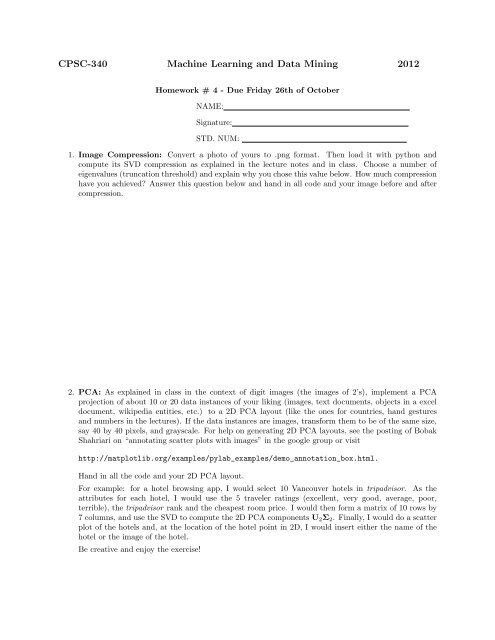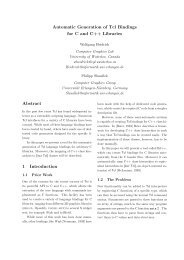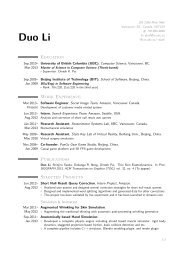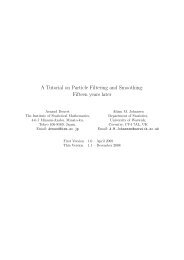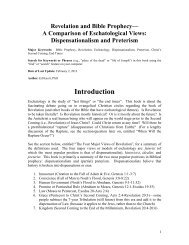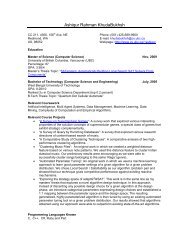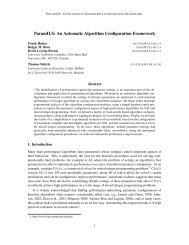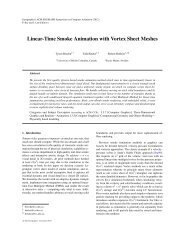CPSC-340 Machine Learning and Data Mining 2012
CPSC-340 Machine Learning and Data Mining 2012
CPSC-340 Machine Learning and Data Mining 2012
You also want an ePaper? Increase the reach of your titles
YUMPU automatically turns print PDFs into web optimized ePapers that Google loves.
<strong>CPSC</strong>-<strong>340</strong> <strong>Machine</strong> <strong>Learning</strong> <strong>and</strong> <strong>Data</strong> <strong>Mining</strong> <strong>2012</strong><br />
Homework # 4 - Due Friday 26th of October<br />
NAME:<br />
Signature:<br />
STD. NUM:<br />
1. Image Compression: Convert a photo of yours to .png format. Then load it with python <strong>and</strong><br />
compute its SVD compression as explained in the lecture notes <strong>and</strong> in class. Choose a number of<br />
eigenvalues (truncation threshold) <strong>and</strong> explain why you chose this value below. How much compression<br />
have you achieved? Answer this question below <strong>and</strong> h<strong>and</strong> in all code <strong>and</strong> your image before <strong>and</strong> after<br />
compression.<br />
2. PCA: As explained in class in the context of digit images (the images of 2’s), implement a PCA<br />
projection of about 10 or 20 data instances of your liking (images, text documents, objects in a excel<br />
document, wikipedia entities, etc.) to a 2D PCA layout (like the ones for countries, h<strong>and</strong> gestures<br />
<strong>and</strong> numbers in the lectures). If the data instances are images, transform them to be of the same size,<br />
say 40 by 40 pixels, <strong>and</strong> grayscale. For help on generating 2D PCA layouts, see the posting of Bobak<br />
Shahriari on “annotating scatter plots with images” in the google group or visit<br />
http://matplotlib.org/examples/pylab_examples/demo_annotation_box.html.<br />
H<strong>and</strong> in all the code <strong>and</strong> your 2D PCA layout.<br />
For example: for a hotel browsing app, I would select 10 Vancouver hotels in tripadvisor. As the<br />
attributes for each hotel, I would use the 5 traveler ratings (excellent, very good, average, poor,<br />
terrible), the tripadvisor rank <strong>and</strong> the cheapest room price. I would then form a matrix of 10 rows by<br />
7 columns, <strong>and</strong> use the SVD to compute the 2D PCA components U2Σ2. Finally, I would do a scatter<br />
plot of the hotels <strong>and</strong>, at the location of the hotel point in 2D, I would insert either the name of the<br />
hotel or the image of the hotel.<br />
Be creative <strong>and</strong> enjoy the exercise!
3. <strong>Learning</strong> Bayesian networks: For the Fritz network that was discussed in the lecture notes, the<br />
joint distribution of the i-th observation is:<br />
P (Ti, Mi, Si, Fi|θ, α, γ1:2, β1:4) = P (Ti|Si, Fi, β1:4)P (Fi|Mi, γ1:2)P (Mi|θ)P (Si|α),<br />
where each distribution is Bernoulli:<br />
P (Mi|θ) = θ I(Mi=1) (1 − θ) I(Mi=0)<br />
P (Si|α) = α I(Si=1) (1 − α) I(Si=0)<br />
P (Fi|Mi = 0, γ1) = γ I(Fi=1|Mi=0)<br />
1 (1 − γ1) I(Fi=0|Mi=0)<br />
P (Fi|Mi = 1, γ2) = γ I(Fi=1|Mi=1)<br />
2 (1 − γ2) I(Fi=0|Mi=1)<br />
P (Ti|Si = 0, Fi = 0, β1) = β I(Ti=1|Si=0,Fi=0)<br />
1<br />
(1 − β1) I(Ti=0|Si=0,Fi=0)<br />
P (Ti|Si = 0, Fi = 1, β2) = β I(Ti=1|Si=0,Fi=1)<br />
2<br />
(1 − β2) I(Ti=0|Si=0,Fi=1)<br />
P (Ti|Si = 1, Fi = 0, β3) = β I(Ti=1|Si=1,Fi=0)<br />
3<br />
(1 − β3) I(Ti=0|Si=1,Fi=0)<br />
P (Ti|Si = 1, Fi = 1, β4) = β I(Ti=1|Si=1,Fi=1)<br />
4<br />
(1 − β4) I(Ti=0|Si=1,Fi=1)<br />
(a) Derive the ML estimates of θ, α, γ1:2, β1:4 for the dataset in the slides. Hint: we did some of these<br />
estimates already in class.
(b) Derive the posterior mean estimates of θ, α, γ1:2, β1:4 assuming that we use the same Beta(1, 1)<br />
prior for each of the parameters. Start by writing each of the 8 posterior distributions. For<br />
example,<br />
P (θ|M1:5) ∝<br />
5�<br />
P (Mi|θ)p(θ)<br />
i=1<br />
∝ θ 4 (1 − θ) 1 θ 1−1 (1 − θ) 1−1<br />
= θ 5−1 (1 − θ) 2−1<br />
<strong>and</strong>, consequently, the posterior mean estimate of θ is E(θ|M1:5) = 5<br />
5+2 = 5/7.
(c) Calculate P (M|T = 0) from the ML estimates of the parameters.
(d) Calculate P (M|T = 0) from the posterior mean estimates of the parameters.
(e) As explained in the last slide of the lectures on Bayesian network learning, assume we have another<br />
model with an arrow from M to S. In this case, P (Si|α) gets replaced by P (Si|Mi, α1, α2). For<br />
the validation dataset in that slide, which model provides a better prediction? Hint: evaluate<br />
� 2<br />
i=1 P (Ti, Mi, Si, Fi|θ, α, γ1:2, β1:4), where i is the index over the two items in the validation<br />
dataset, for both models. Note that for model 2, you first have to learn α1:2.
4. Bayesian linear regression Let X ∈ R n×d <strong>and</strong> y ∈ R n×1 . Assume the likelihood is Gaussian:<br />
Assume that the prior for θ is also Gaussian:<br />
p(y|X, θ, Σ) = |2πΣ| −1/2 1 −<br />
e 2 (y−Xθ)T Σ −1 (y−Xθ)<br />
.<br />
p(θ) = |2π∆| −1/2 1 −<br />
e 2 θT ∆ −1 θ<br />
.<br />
(a) Using Bayes rule <strong>and</strong> completing squares, derive an expression for the posterior distribution of θ.<br />
In this part, assume that the covariance Σ is given. State clearly what the mean <strong>and</strong> variance of<br />
the posterior are.<br />
(b) State the conditions under which the posterior mean would be equivalent to the ridge <strong>and</strong> maximum<br />
likelihood estimators.


